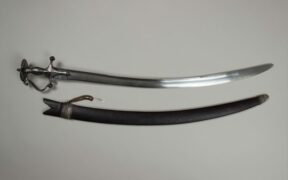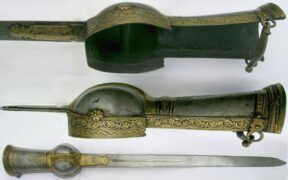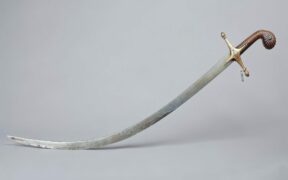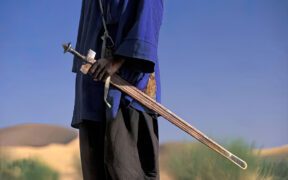Our content features commercial links to our products, committed to transparent, unbiased, and informed editorial recommendations. Learn More
Khanda Sword: The ‘Last Stand’ Indian Sword
NO AI USED This Article has been written and edited by our team with no help of the AI
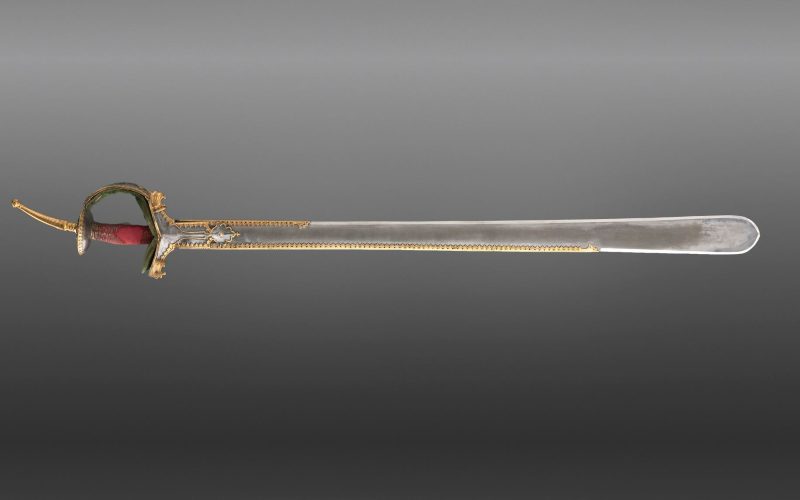
The Khanda sword is an Indian straight sword with two sharp edges. Otherwise known as the Last Stand Indian Sword, it is similar to other Asian swords as it was employed for various purposes such as battle. The long broad double edge Khanda was also used ceremonially and religiously, making it a representation of the god Shiva in certain ancient Indian religions.
In this article, we will discuss everything you’ll need to know about the usage of the Khanda sword and what it represents in the Khanda symbol. In addition, we will be showing you some modern Khanda swords, what to look for when purchasing one, its characteristics, and how it developed into a ceremonial object and serves as a powerful religious symbol in the Indian Peninsula.
Characteristics of the Khanda Sword
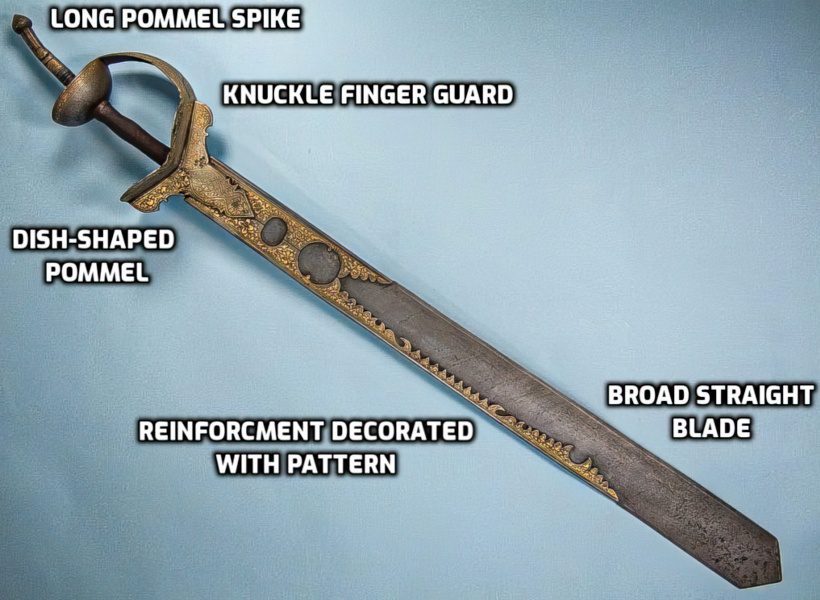
The most recognizable appearance and characteristic of the Khanda sword is definitely the broad sword ending. Unlike many other swords, which taper at the end to provide more power when thrusting, the blade of the Khanda sword stays the same width throughout. Or it may even be broader than the neck of the sword.
Blade
The blade of the Khanda sword is unorthodox looking as it broadens towards the tip, making it unsuitable for thrusting actions and much more effective for slashing. In addition, one side of the blade is often sharper than the other.

The Khanda blade was fashioned by swordsmiths and had a metal plate on one side along the length of the blade. This increased the weight of the sword, allowing for more powerful cuts while also allowing fighters to grasp the Khanda’s blade – on the side with the plate – without cutting or harming themselves.
Weight
The Khanda sword usually weighs around 1.2 – 1.3 kg, making it light enough for a soldier to wield one-handedly while holding a shield in the other. However, they were also heavy enough to be used with both hands for extra leverage and power.
Size & Length
The usual length of the Khanda sword is around 90 – 100 cm. It has a width of about 3.8 – 4 cm with a thickness of 1.5 cm.
Grip & Pommel
The broad plate guard and wide finger guard connect the larger circular, flat pommel on the hilt. The pommel has a spike that serves to protect the arm when using two hands to wield the sword.
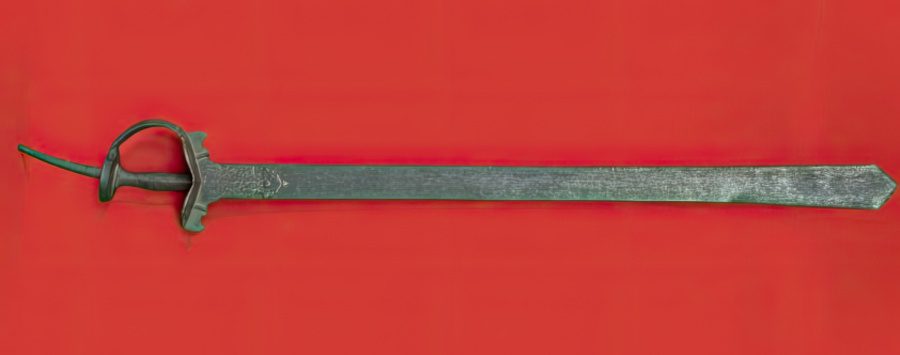
The extra pommel at the end of the Khanda not only protects against an unwanted strike but also provides additional power and strength when used for slashing while holding the sword with both hands. Using both hands from two different angles (one lower and one higher) applies more force to the blow.
The extra pommel also serves as a hand rest when the blade is sheathed. The interior of the guard, as well as the finger guard, is cushioned/padded.
Guard

The Khanda sword has a separate finger guard. It is made this way purely to protect the user’s hand, as the sword was mainly used for slashing, which meant that the soldier’s hand could get struck in the open. It also provided the strength that held the blade in one place while being elastic in the middle and end.
Uses of the Khanda Sword
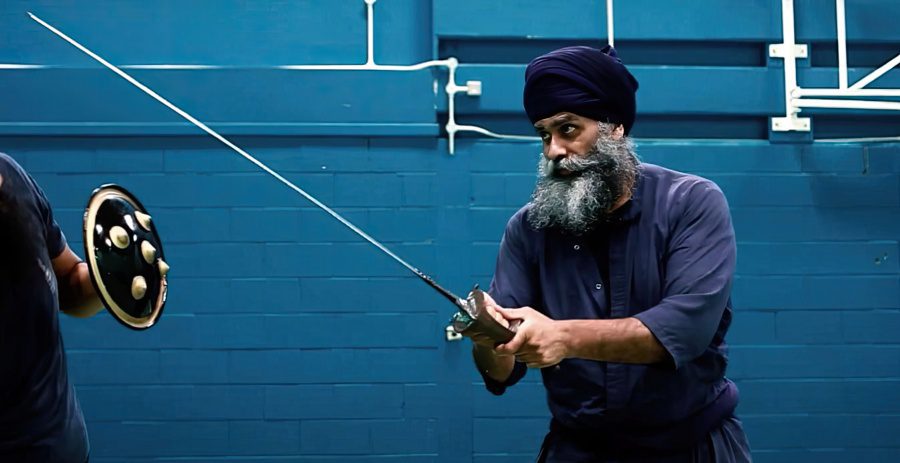
The Khanda sword was a primary weapon mainly used as a terrifying two-handed slashing weapon. It was sometimes used in combination with a shield, such as using it in the Kalaripayattu Indian martial art.
The bottom of the Khanda sword is lighter than the top, making it easy to use and allowing for a greater impact as it swings into the enemy. That is why, despite being a straight blade, it is utilized for slashing strikes rather than thrusting. It can sometimes be used as a mace because of the top-heavy sword edge capable of delivering powerful blunt strikes to an armored opponent.
In combat, Rajput soldiers used two hands to swing the Khanda above their heads to fight multiple opponents at once. Some Rajput warriors would use the Khanda as a last-stand weapon. If a fighter were outnumbered and had little hope of fleeing, he would hit as many opponents as possible with an overhead swing. This was something that the Sikh soldiers were doing too.
Best Khanda Swords Available on the Market
The Khanda sword is rare when it comes to buying real quality. Most of the ones you will find will be decorative pieces that are usually bestowed as gifts or used in ceremonies.
We collected a list of swords to assist you in selecting the best Khanda sword, depending on your needs.
1. Best Overall – Rajasthan Gems Damascus Steel Khanda Sword
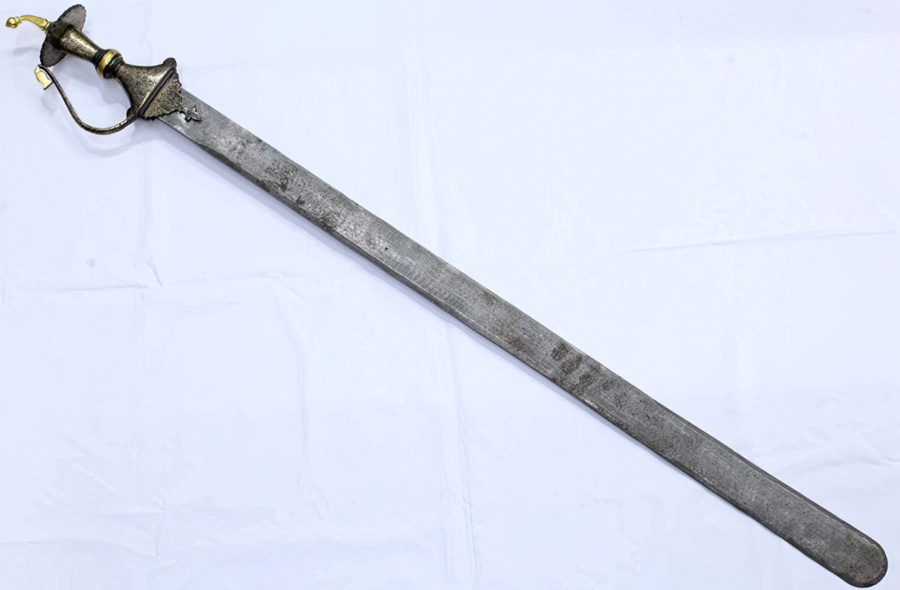
Are you looking for a rare Khanda sword? This Gems Damascus Steel Khanda Sword has an old gold wirework handle and a lovely hand-carved koftgari calligraphy artwork. The blade is 97 cm long, which is the traditional length of the Khanda sword. The neck is lighter than the end, allowing for more freedom of movement. This sword is also wider on the tip of the blade. Unfortunately, its rarity makes it reasonably expensive compared to other swords.
2. Best for LARPing – Rajasthan Gems Chiseled Steel Khanda Sword
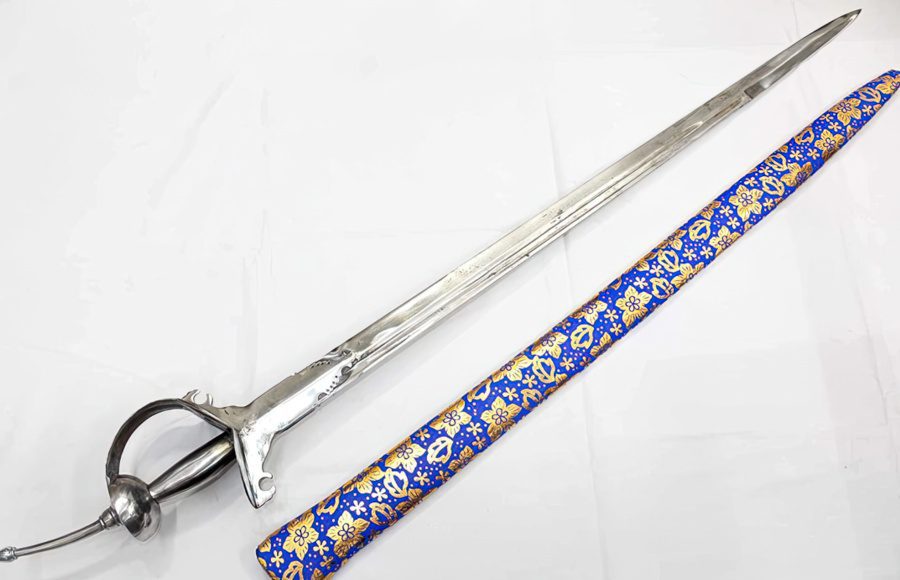
This is a Khanda sword made entirely of chiseled steel from the start of the pommel to the tip of the sword. This Khanda sword is also made with a tapered tip, unlike the traditional wider end.
That is why you can use this $400 mid-priced sword as a thrusting and a slashing weapon. The length of this sword is 42 inches, and the blade is made from old handmade alloy steel. It comes with a very decorative scabbard to sheath this stainless steel blade.
3. Best for Length – Rajasthan Gems 46 inch Khanda Sword
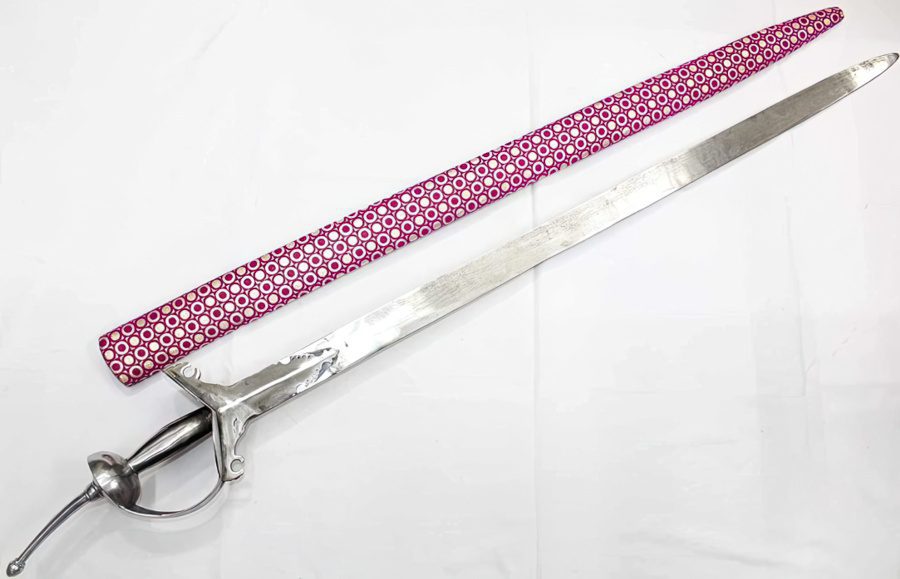
This is one of the longer Khanda swords available. The blade is made from handmade alloy steel and silver in color. As you can see, the scabbard is a very unique color that matches the sword.
The pointy end of the pommel and the guard are also made from steel. This is a reproduction sword that is not that hard on the budget and a ready-made weapon with a pointy end, unlike the traditional and original Khanda sword. It also comes with a relatively longer scabbard decorated with lively patterns.
Ceremonial Usage of the Khanda Sword
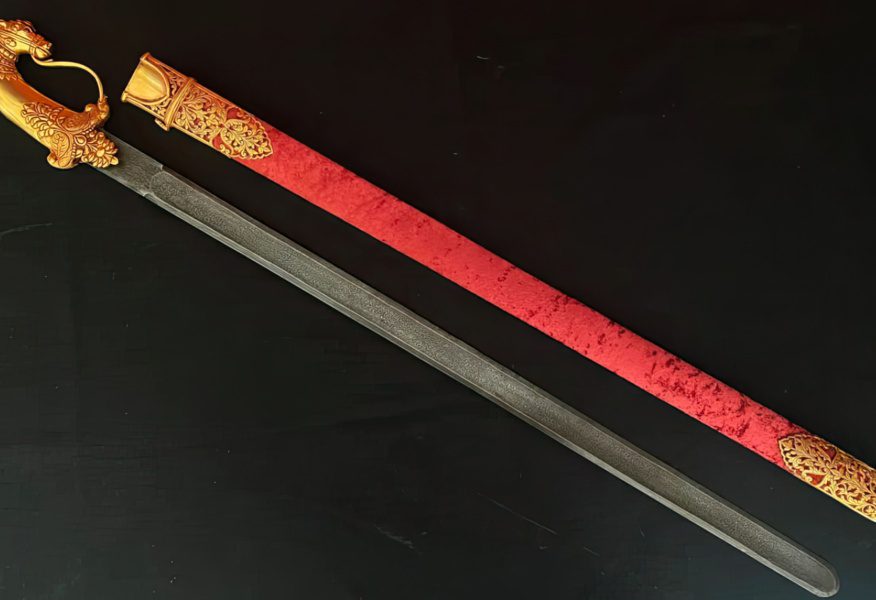
The biggest use of the Khanda sword in the past and present was for religious ceremonies or holidays. Owning a quality handmade Khanda sword meant that you are royalty and connected with wealth and respect.
An example of such a prestigious sword would be this handmade Indian Khanda sword made of copper and gilded gold. The hilt of this sword is made of copper, beautifully hand carved into a horse face and has been gilded with gold.
The hilt is equipped with a knuckle guard. The horse’s eyes are encrusted with semi-precious stones. The talwar locket is hand-carved by the Royal family’s craftspeople and carefully fashioned from copper sheets. The chape is also hand-chiseled and cut from copper.
The blade is composed of Damascus steel and has a single-edge blunt blade. This is a traditional Rajput Sikh wedding ceremonial sword used by provincial royals.
History of the Khanda Sword
The Khanda sword is an antique sword and one of the earliest Indian swords, dating back to the second century AD. The Khanda sword was most likely first used during the Gupta period, from 319 to 467 / 550 CE.
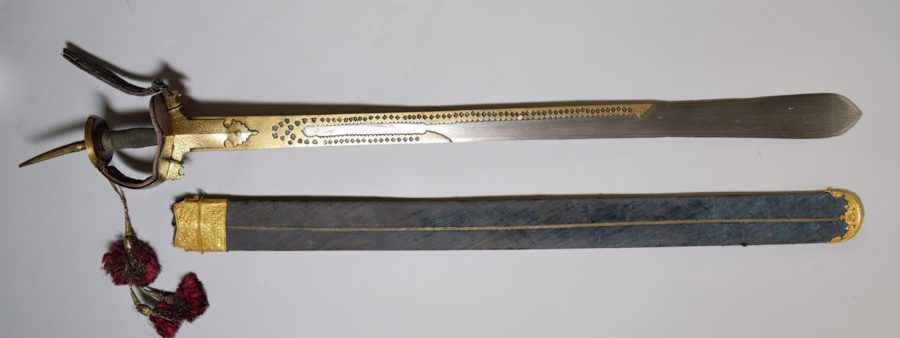
The traditional Khanda swords were huge, hefty, and featured double-edged blades that broadened towards the point. These swords were deep-slashing weapons of ancient and medieval India. The blades were frequently strengthened on a single edge.
The Khanda sword’s well-recognizable form became more recognized in the late 17th century. For better usage and defense, swords with basket hilt were developed, making it the weapon as we know it today.
Religion & Beliefs
The Khanda sword is described as a tool of wisdom penetrating through the curtain of ignorance in Dharmic faiths such as Hinduism. In 18th-century and 19th-century art, Hindu and Buddhist deities are frequently seen brandishing or clutching Khanda swords.
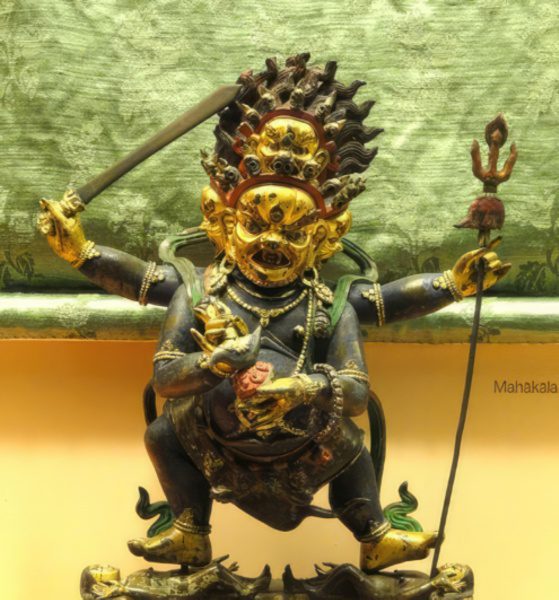
The term Khanda derives from the Sanskrit Khaga, the root Kha, which means “to shatter, divide, cut, or demolish.” An older word for the Khanda sword was simply ‘asi’, which meant sword or dagger.
Khanda Sword and Khandoba
Khandoba is a Hindu Deity and connected with the Khanda sword on multiple occasions. He wields a spear and a Khanda and battles demons while mounted on his horse.
The name ‘Khandoba’ comes from the terms Khadga or Khanda (sword), which Khandoba used to slaughter the demons, and “ba” (father).
Khanda Sword and Maharana Pratab
The Khanda sword was also used by the great folk Indian hero Maharana Pratab. He is a legend in India for his outstanding resistance and fights against the Mughal expansion. It is said that in the battle of Haldighatti, the chances were stacked against him that the fight was of the same style as the Khanda sword – the last stand.
What is the Khanda Symbol?
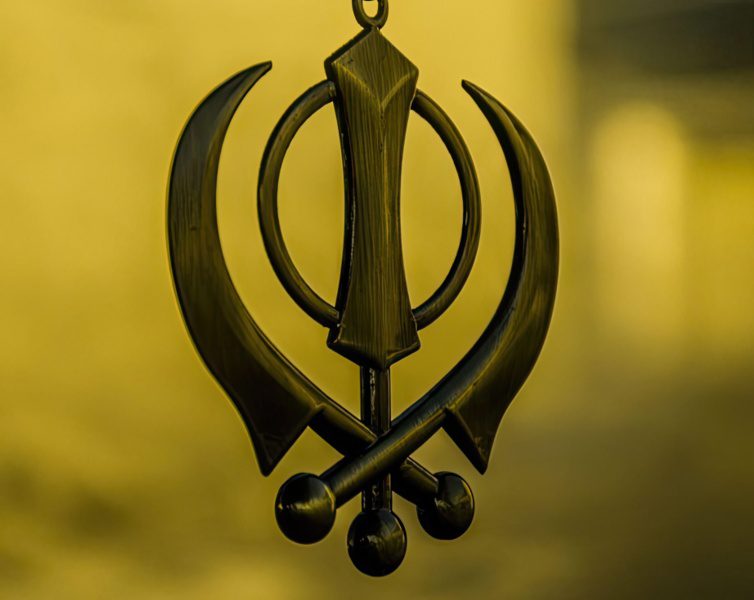
The Khanda or Sikh Symbol is a symbol that represents the Sikh faith and traces its origins in the 1930s from the Ghadar movement. The Khanda symbol has a couple of very recognizable emblems and has the Khanda sword in the middle.
- Chakkar – The Chakar circlet is a throwing weapon that Sikh warriors have historically employed in combat. It represents unity on the Khanda symbol.
- The Two Swords Miri and Piri – The two swords of Miri and Piri are symbols that establish the power and authority of Guru Har Govind (it is a Guru from the Sikh religion) after he slew his father. It represents the secular forces that might impend the soul.
- Khanda Sword – The Khanda sword in this symbol represents and is used to stir the immortalizing Amrit nectar. This Amrit nectar is drunk while religious baptism Sikh ceremonies are in process. Also, the double edge represents the power to cut the dualism of delusion.
In Sikhism, to this day, the Khanda sword, together with the Kirpan (a small dagger used by Sikh believers), is the most significant and religious object to represent respect and culture.
Khanda Sword vs. Khadga Sword

The Khanda sword was a broad sword used on many occasions through battle and war in myths and real life. It featured a relatively strong long blade that could cut through armor and flesh effortlessly if wielded properly through slashing strikes. With time, the Khanda sword began to be used more for ceremonial purposes.
By contrast, the Khadga sword is a ceremonial sword and nothing more. Even by its sheer looks, anyone could tell that if this weapon was used in battle, the ornaments, which are plenty and everywhere, could get caught on something small that could result in death. Even the handle of the Khadga sword will injure your hand if used with force.
Both swords are ceremonial weapons in India with very high standards. The difference between them is that the Khanda sword was actually used for battle, whereas the Khadga was strictly for ceremonial and religious (most of the time sacrificial) purposes.
What is the European Version of the Khanda Sword?

The Khanda sword’s closest resemblance to a European version would be the Executioner’s sword. This is because they have the same long blade neck, which usually ends up in the same broadening size at the end, like in the Khanda.
The Executioner’s sword was used purely for executions (usually beheading). That is why we can be confident that fighting in this style and format would have caused much slashing damage, even to armored opponents. This leads us to question if the Khanda sword is the strongest Indian sword.
Is the Khanda Sword the deadliest Indian Sword?
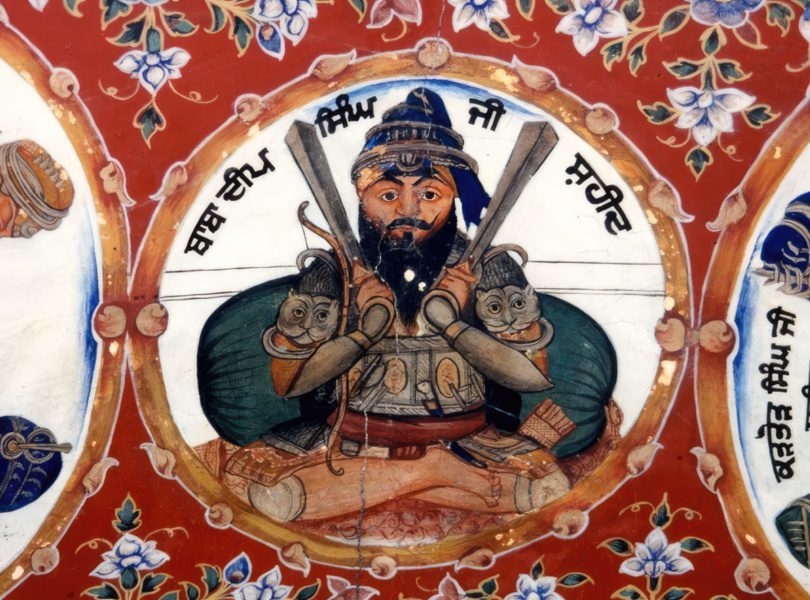
The Khanda sword is not the deadliest Indian sword, although some might say otherwise. It has been used by many soldiers in the past and certainly had its success before the introduction of the Talwar sword. However, after the Talwar sword came about, the Khanda was not nearly as successful as the Talwar Indian sword in causing fatalities.
The Talwar came after the Khanda sword, a perfect substitute for it, especially for mounted warfare. However, that doesn’t mean that the Khanda wasn’t deadly. On the contrary, it was used for extreme situations where giving up was the only other solution. That is why you can see big Indian warriors like Baba Deep Singh holding two Khanda swords in his hands, having achieved martyrdom.
Conclusion
The Khanda sword is the most revered and well-known artifact in the Sikh religion, as well as one of the highest-ranked Indian swords, making it a must-have for every sword collector. This sacred artifact may be found in practically every statue and temple in India, as well as in many theatrical productions and classical Indian dances such as the Kathakali.
